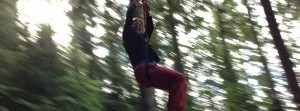
Comment: More to the Fossil Story
“The Colossal Fossil Conundrum,” published in the June/July issue of Northword, is a good introduction to one side of fossil issues in Canada. I would like to offer a view from the other side.
Gordon Harvey left the Driftwood fossil bed to the care of Parks so British Columbians could enjoy finding, extracting, and placing on their mantels evidence of the earth’s past history. What Harvey didn’t know at the time of his bequest was that the government would pass laws forbidding the removal of fossils from parklands by anyone except scientists and their assistants. Harvey made this gift in good faith and Parks does its part by protecting that land and its artifacts.
The fear now by scientists and Parks, as the article points out, is that people will go into parkland, or any other private or public land for that matter, and take fossils that could be important to science.
This is a legitimate fear. What is not said, though, is that fossils left in the field erode, slough and disappear.
This happened with what is believed to be the world’s largest ichthyosaur fossil that was found on the Graham River near Dawson Creek. It was discovered and reported to the Prince George museum by amateurs, but the professionals had no time to get to it. With the help of amateurs, a smaller ichthyosaur from the same area was extracted by professionals from Drumheller and lodged in Alberta’s Tyrrell Museum. The larger fossil eroded, chunk by chunk, into the river, and the people of northern BC lost access to the smaller one.
The man from Germany, mentioned in the Northword story, who found a bird fossil at Driftwood, kept it safe from erosion for 40 years and then willingly gave it to Dr Archibald when he asked for it. Had the fossil been left in the canyon, especially since it was a rock found on the surface, it would not have been available to anyone. This shows the necessity of maintaining good relations with amateurs, which will not happen if they are prohibited from pursuing their hobby.
Kakwa Provincial Park has dinosaur tracks and fossils. One trackway, when found, was considered the most significant in Canada. Rich McCrea of the Tumbler Ridge Museum obtained exclusive rights for five years to study the trackway. He went in once and, due to time, weather, money and more pressing interests, has not returned. Because this is a vertical wall, rocks slough every year and there is a grand chance that there will soon be little left of the “most significant” trackway site in Canada.
Jim Senka, mentioned in the story, would like to form a group to assist in managing the fossils at Driftwood. The McAbee Fossil Bed, just 13 km east of Cache Creek, had already implemented such a concept. McAbee had an informed amateur, John Leahy, manning the site during tourist season, a person who accompanied school groups when they visited, a person who vetted all the fossils found by tourists and kept those that were uncommon or different. Leahy then cleaned, photographed, catalogued and offered these finds to all the scientists in the world; many of those scientists used the finds to make great contributions to science. These scientists have acknowledged Leahy’s professionalism and contribution to their work.
But some scientists weren’t happy with this. They were afraid that one or two fossils might get away unnoticed, that some might be stolen, that some might be kept hidden so the man vetting the fossils wouldn’t see them. The government listened to the scientists and expropriated the McAbee site. It now sits fallow with an official notice stating that only those with written approval are permitted to enter. I find the notice insulting to the land-owners, who are specifically named on the notice. They were the ones who first developed and explored the site with the expectation that their contribution would be beneficial to scientists.
I must add that the McAbee site is a mirror image of sites in the US and United Kingdom that run exactly as McAbee did, where they charge people to come and extract fossils according to the laws of the land, and where they offer important finds to scientists. The visitors keep the common ones. These businesses also make money and pay taxes.
What the story of BC fossil management says to me is that places like Driftwood, McAbee and Kakwa have become private estates that the scientists visit for a few weeks every year and sometimes not even that, while we sit on the sidelines and watch the fossils deteriorate—all at our expense.
Dr Archibald says in the Northword story that locals “don’t often know what a resource they have,” and this is true. What he doesn’t say is that if we are kept from the fossil beds, no one will ever know the true value of the resource.



